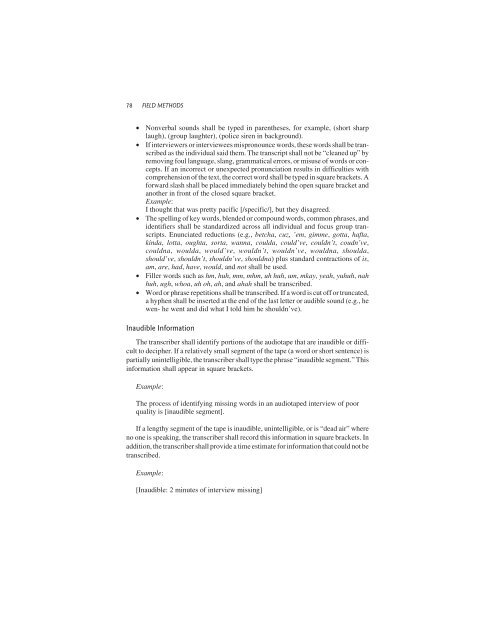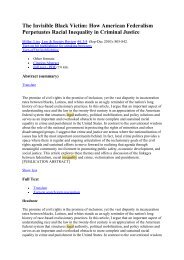Beyond the Qualitative Interview: Data Preparation and ... - E-Journal
Beyond the Qualitative Interview: Data Preparation and ... - E-Journal
Beyond the Qualitative Interview: Data Preparation and ... - E-Journal
You also want an ePaper? Increase the reach of your titles
YUMPU automatically turns print PDFs into web optimized ePapers that Google loves.
78 FIELD METHODS<br />
• Nonverbal sounds shall be typed in paren<strong>the</strong>ses, for example, (short sharp<br />
laugh), (group laughter), (police siren in background).<br />
• If interviewers or interviewees mispronounce words, <strong>the</strong>se words shall be transcribed<br />
as <strong>the</strong> individual said <strong>the</strong>m. The transcript shall not be “cleaned up” by<br />
removing foul language, slang, grammatical errors, or misuse of words or concepts.<br />
If an incorrect or unexpected pronunciation results in difficulties with<br />
comprehension of <strong>the</strong> text, <strong>the</strong> correct word shall be typed in square brackets. A<br />
forward slash shall be placed immediately behind <strong>the</strong> open square bracket <strong>and</strong><br />
ano<strong>the</strong>r in front of <strong>the</strong> closed square bracket.<br />
Example:<br />
I thought that was pretty pacific [/specific/], but <strong>the</strong>y disagreed.<br />
• The spelling of key words, blended or compound words, common phrases, <strong>and</strong><br />
identifiers shall be st<strong>and</strong>ardized across all individual <strong>and</strong> focus group transcripts.<br />
Enunciated reductions (e.g., betcha, cuz, ’em, gimme, gotta, hafta,<br />
kinda, lotta, oughta, sorta, wanna, coulda, could’ve, couldn’t, coudn’ve,<br />
couldna, woulda, would’ve, wouldn’t, wouldn’ve, wouldna, shoulda,<br />
should’ve, shouldn’t, shouldn’ve, shouldna) plus st<strong>and</strong>ard contractions of is,<br />
am, are, had, have, would, <strong>and</strong> not shall be used.<br />
• Filler words such as hm, huh, mm, mhm, uh huh, um, mkay, yeah, yuhuh, nah<br />
huh, ugh, whoa, uh oh, ah, <strong>and</strong> ahah shall be transcribed.<br />
• Word or phrase repetitions shall be transcribed. If a word is cut off or truncated,<br />
a hyphen shall be inserted at <strong>the</strong> end of <strong>the</strong> last letter or audible sound (e.g., he<br />
wen- he went <strong>and</strong> did what I told him he shouldn’ve).<br />
Inaudible Information<br />
The transcriber shall identify portions of <strong>the</strong> audiotape that are inaudible or difficult<br />
to decipher. If a relatively small segment of <strong>the</strong> tape (a word or short sentence) is<br />
partially unintelligible, <strong>the</strong> transcriber shall type <strong>the</strong> phrase “inaudible segment.” This<br />
information shall appear in square brackets.<br />
Example:<br />
The process of identifying missing words in an audiotaped interview of poor<br />
quality is [inaudible segment].<br />
If a lengthy segment of <strong>the</strong> tape is inaudible, unintelligible, or is “dead air” where<br />
no one is speaking, <strong>the</strong> transcriber shall record this information in square brackets. In<br />
addition, <strong>the</strong> transcriber shall provide a time estimate for information that could not be<br />
transcribed.<br />
Example:<br />
[Inaudible: 2 minutes of interview missing]














